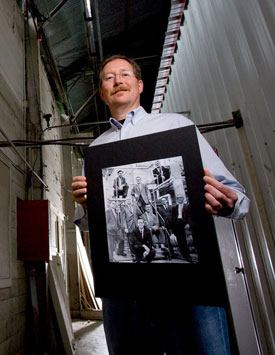Alumnus, son of a ChE department founder shares his memories
The rain was steady and cold, but Scott Prengle (1981 BSEE, 1984 MSEE) had braved it without an umbrella.
Ducking his head in from the drizzle he surveyed the dusty Y Building, now very much wearing its age, as a grin began growing over his face.
The memories, fifty years worth, had begun rushing in. Not even the loud, pounding showers or the occasional dribble from the tin roof could wash them out.
There was the zoo smell that always flooded his nostrils as he passed the psychology department’s monkeys kept just outside. And the picture formed in his once nursery school mind of the large, noisy lab machines that used to tower like skyscrapers in middle of the space.
It had been decades since he had made the trip from his Dallas home to the University of Houston, but the longtime campus structure had always held a close place in his heart.
The son of H. William Prengle, his father and colleagues Joseph R. Crump and Abraham E. Dukler, played a significant role in the UH Cullen College of Engineering’s early beginnings. Together, they founded what is now the college’s department of chemical and biomolecular engineering—holding its first classes and labs in the building tucked away on the northeast side of the main campus.
For more than half-a-century it’s remained a landmark on the grounds. Soon it will exist, like his memories, only in his mind as the college prepares to tear it down and make way for something new. But the rich history the building represents will not be lost on Prengle.
Many early childhood memories were set in the building, as a toddler, on the heels of his father.
“I had the great experience of getting to go through the Y Building many times back in the early 1960s while staying in close proximity to my father as he made the rounds to look at students’ projects that were running in the building,” he explained near to the day of the fourth anniversary of his father’s death. “I remember how big and noisy the place seemed, but that was through the eyes of a 3-year-old.”
Walking the cobweb-speckled halls, he gazed at the skinny black signs bearing room numbers still hanging, some in pieces, above doorways. These were once the classrooms where his father taught part-time while working at Shell just prior to signing on, in 1952, as an associate professor of chemical engineering and beginning efforts to start a full-time chemical engineering program.
They were the same rooms where early deans had offices. Students gathered to commit to memory the weeks’ toughest curriculum, and new ways of doing things were born.
As he moved from one end to the other and back again he pointed out the little inconsistencies. Instruments missing here and a student organization office moved from over there, some things just didn’t align with the pictures in his mind.
He, of course, had plenty to draw from. For years, his father regularly plucked the tot from UH daycare to see what he was helping build—a well-rounded program offering both undergraduate and graduate options that was on its way to being nationally ranked.
It was in those early years, Prengle said, he saw first-hand students studying engineering, the profession he would later pursue at UH in the spring of 1978.
Studying, research and even a few childhood memories of the noise in the building kept him from visiting as frequently in the 1980s as he had with his father. But the building, he said, was never out of sight.
“When I was a graduate student in electrical engineering, I worked in the E&X Lab for Dr. Wolfe up on the third floor of the old engineering building,” he said. “The lab, where we had our sputter deposition and ion etching chambers, was on the side of the building where I could look out and see the Y building.”
Though it’s lived for years with a haggard appearance, Prengle, now a program manager at DNS Electronics, was in awe it had stood up to serve even these last years. His visit, and the memories it stirred, reinforced the unwavering symbol of character and strength the building has been for many at the college.
“In my mind, it’s reflected the roots of the college,” he said. “A place literally pulled up by its own bootstraps on the strong, broad shoulders of some visionary teachers and administrators who, when they looked at the Y Building didn’t just see an ugly metal building of questionable rigidity, they saw the future and it has weathered every storm.”
